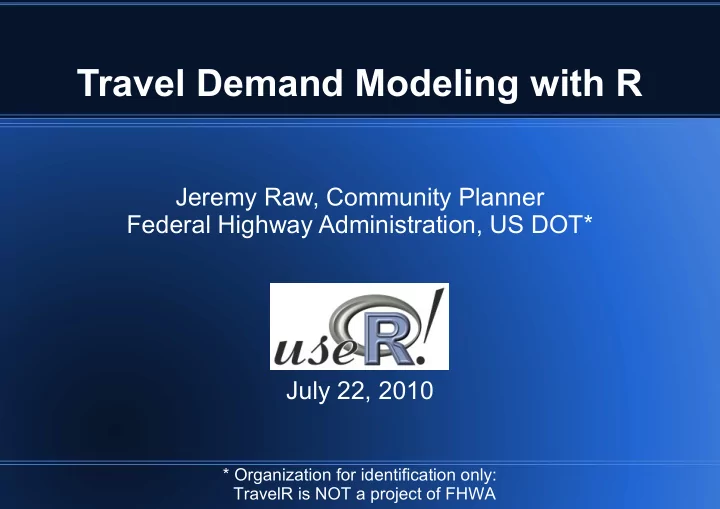

Travel Demand Modeling with R Jeremy Raw, Community Planner Federal Highway Administration, US DOT* July 22, 2010 * Organization for identification only: TravelR is NOT a project of FHWA
What is Travel Demand Modeling? Forecasting future demand and utilization of transport facilities Uses system structure and demographic data Road and Transit Networks − Trip purpose − Population and Household structure − Economic activity −
Scope of Travel Models Travel models are generalized over regions Transportation Analysis Zones − Simplified highway and transit networks − Often generalized over time periods Estimates for the morning peak period... − … or perhaps an entire day −
Zones and Network
Evolution of Travel Models Simplest models are “trip based” How many trips on which routes − More recent models may include A simulation component (to capture − bottlenecks) Much greater detail on trip purpose and − household structure Extensive feedback to capture behavioral − changes in response to system load
Basic Layout of a Travel Model Basic Modeling Operations Trip or Tour Generation (e.g. Home to Work) Network Skims (Zone to Zone travel costs) Trip Distribution (Zone to Zone demand) Mode Split ( bus / auto / other ) Assignment ( route actually chosen ) These operations come in different flavors Trip-based, Tour-based, Activity-Based Most models include feedback loops
Travel Modeling Computations Predictive Statistical models For trip and activity demand For mode share analysis Vector and Matrix computations For trip distribution and tour formation Network analysis “Best” paths, with congestion sensitivity
Why use R for Travel Modeling? Great presentation graphics Fast, efficient vector and matrix calculations Easy access to data stored in other formats Interactive and Easy to learn Can replace spreadsheets − Simple to script and to debug Provides tools for (almost) all computations
Who Does Travel Modeling in R? R is used frequently by individual modelers Oregon DOT has built their entire modeling program around R Including GreenSTEP, a Greenhouse Gas − analysis tool
What tools exist for Travel Modeling in R? Available R packages have supported most required computations The only noteworthy exception until recently has been traffic assignment The TravelR project aims to provide that functionality
Technical Goals of TravelR Provide missing functionality Traffic Assignment − Multiple vehicle classes Dynamic turn penalties Select Link analysis One-step Matrix Operations − Iterative Proportional Fitting Redistricting
Community Goals of TravelR Encourage "open" travel models: Clear assumptions − Documented algorithms and data − Easy to exchange ideas, research and − models
A whole (simple) model in R (1) data(SiouxFalls) ################ Trip Generation ################# productions<-rowSums(SiouxFalls.od) attractions<-colSums(SiouxFalls.od) ################ Highway Skims ################# cost.function<-with(SiouxFalls.net$Links, function(...) FFTime) aclass <- make.assignment.class(SiouxFalls.net, "All", SiouxFalls.od) aset <- new.assignment.set(SiouxFalls.net,list(All=aclass), cost.volume.type="vector", cost.function=cost.function) paths <- build.paths(aset, aset$ff.cost) travel.times <- skim.paths(paths,aset$ff.cost)[["All"]]
A whole (simple) model in R (2) ################ Trip Distribution ##################### base.distribution <- hwy.gamma.function(travel.times,-0.02,-0.123) ● # HBW coefficients from NCHRP 365 trip.table <- ipf(base.distribution,list(rows=productions, cols=attractions),method="absolute") aset <- hwy.update.demand(aset,"All",trip.table) ################ Trip Assignment ##################### assignment.results <- highway.assign(aset,method="Frank.Wolfe") loaded.links <- assignment.results$volumes
TravelR: Highway Networks Highway network is a directed graph Edges (“Links”) have flow capacity attributes Privileged vertices (“centroid nodes”) correspond to sources and sinks for demand Centroids are the center of a traffic zone TravelR can import networks from data tables
Basic Highway Path Operations Generate Shortest Paths Span “centroids” only, not all vertices Compute (“skim”) path values Apply function to a vector of attributes along a path e.g. Add up total path distance or traversal time Return a zone-to-zone matrix of values “Load” values from demand matrix onto shortest paths Accumulate zone-to-zone values for each link in each path
Unique Requirements for Paths Turn Penalties Path-based costs at junctions Prohibited turns Delay due to crossing traffic Select Link Analysis Compute volume or skim values for selected paths Intercepting (“Selecting”) a certain link or set of links Between certain zone pairs
Highway Path Implementation Low Level Functions written in C++ Features Include: Optimized Shortest Path Building (zone to zone) Low-level turn penalty management Low-level link intercept management (select link) Optimized Skim and Load operations Simple R Interface
The Highway Assignment Problem The Highway Assignment problem: Map a demand matrix onto network links Link costs increase with flow volume Generate minimum cost route allocation Common algorithms Frank-Wolfe (Convex Combinations) Many variations…
Unique Requirements for Assignment Multiple Vehicle Classes Not all vehicle classes respond equally to congestion Trucks versus Passenger Automobiles
Highway Assignment Implementation Assignment class defines Network subset (e.g. HOV lanes removed) Penalty subset (e.g. Rush hour no-left-turns) Demand Matrix (zone to zone demand) Cost Function (or “Volume/Delay Function”) Controls how this class perceives cost increase due to increased link volume
Highway Assignment Implementation Assignment Set defines A collection of Assignment Classes Single-occupant vehicles High-occupancy vehicles Trucks … Highway assignment finds optimum network flow for all classes in an Assignment Set
Directions for TravelR… Long-range goal: A common platform for travel model research Travel modeling has been dominated by closed source, proprietary software Slow rates of innovation Difficulty communicating, testing and disseminating research results R is an ideal platform for interactive investigation of modeling strategies
Where to Find Out More? Travel Model Improvement Program http://tmip.fhwa.dot.gov The TravelR Package http://travelr.r-forge.r-project.org http://r-forge.r-project.org/projects/travelr
Why we Need Open Models Find an elegant cartoon summary of all that can go wrong with statistical models here: http://www.xkcd.com/605
Recommend
More recommend